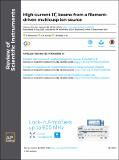High-current H2+ beams from a filament-driven multicusp ion source
Author(s)
Winklehner, D; Conrad, JM; Smolsky, J; Waites, LH
DownloadPublished version (10.18Mb)
Publisher with Creative Commons License
Publisher with Creative Commons License
Creative Commons Attribution
Terms of use
Metadata
Show full item recordAbstract
We report the results from a new multicusp ion source (MIST-1) that produces record steady-state currents of H2 + (1 mA) from this type of ion source with high purity (80% H2 +). We built MIST-1 to fulfill the stringent beam purity and beam quality requirements for IsoDAR, a proposed discovery-level neutrino experiment, requiring a 10 mA, 60 MeV/amu continuous wave (cw) proton beam on the target. IsoDAR will use a cyclotron accelerating H2 + ions and using a novel radio frequency quadrupole (RFQ) direct injection method. Systematic measurements, varying discharge voltage, discharge current, and gas pressure, indicate that the ideal operating regime is at low pressure, high discharge current, and high discharge voltage. We have measured the combined species emittance after the source extraction to be <0.05 π-mm-mrad (rms, normalized) for a 0.95 mA beam. Beyond showing high currents and high H2 + fraction, our measurements agree well with high fidelity simulations. These results show the feasibility of using a multicusp ion source for IsoDAR and the RFQ direct injection prototype and paves the way to record breaking cw beam currents of 5 mA H2 + (equivalent to 10 mA protons) from compact cyclotrons, ideal for underground installation.
Date issued
2021-12-01Department
Massachusetts Institute of Technology. Department of Physics; Massachusetts Institute of Technology. Laboratory for Nuclear ScienceJournal
Review of Scientific Instruments
Publisher
AIP Publishing
Citation
Winklehner, D, Conrad, JM, Smolsky, J and Waites, LH. 2021. "High-current H2+ beams from a filament-driven multicusp ion source." Review of Scientific Instruments, 92 (12).
Version: Final published version